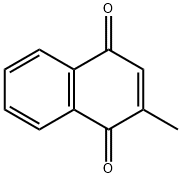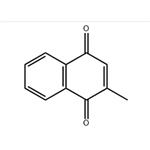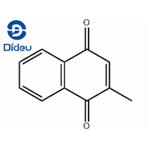Chemical properties
It appears as white crystalline or crystalline powder, being almost odorless and hygroscopic. Its color will change in case of light. It is easily soluble in water, slightly soluble in ethanol, but insoluble in ether and benzene.
Application
Menadione is a good hemostatic drug, its main function is to participate in the synthesis of thrombin, promote blood coagulation, can effectively prevent bleeding diseases, and also participate in the mineralization of bones. Menadione is also an important component of feed additives, an indispensable nutrient for the growth and development of livestock, and can also be used as plant growth regulators, promoters, herbicides, etc.
Production
Menadione is synthesized by oxidizing 2-methylnaphthalene with chromic anhydride and then reacting with sodium bisulfite.
Reaction: Dissolve 2-methylnaphthalene in glacial acetic acid, stir and cool to below 40°C, slowly add a mixture of chromic anhydride and an equal amount of water, and maintain the temperature at 35-40°C. After the addition, the temperature was kept at 40 °C for 0.5 h, then heated to 70 °C for 45 min, and then heated to 85 °C for 15 min. The reactant was poured into a large amount of water, and menadione was precipitated under constant stirring. After filtering, the filter cake was repeatedly washed with water until the aqueous solution had no sour taste, and then filtered to obtain Menadione. Yield 51%.
Description
Vitamin K is a general term referring to a group of naphthoquinone derivatives required in the diet for blood clotting. Menadione is a fat-soluble vitamin that is essential for blood clotting. It is destroyed by irradiation during processing but has no appreciable loss during storage. It occurs in spinach, cabbage, liver, and wheat bran.
Chemical Properties
Bright-yellow crystals with a very faint acrid odour. Insoluble in water; soluble in benzene (1 g/10 mL), ethanol (1 g/60 mL), and vegetable oils (1g/50 mL); moderately soluble in carbon tetrachloride and chloroform. Stable in air; decomposed by sunlight; destroyed by alkalis and reducing agents.
Physical properties
Appearance: phylloquinone is a yellow oil at room temperature, but the other vitamers K are yellow crystals. Solubility: the vitamers K and MK and most forms of menadione are insoluble in water, slightly soluble in ethanol, and readily soluble in ether, chloroform, fats, and oils. Stability: the vitamers K are sensitive to light and alkali, but are relatively stable to heat and oxidizing environments.
Menadione, the formal parent compound of the menaquinone series does not
occur naturally but is a common synthetic form called menadione (2-methyl-1,4-
naphthoquinone). This compound forms a water-soluble sodium bisulfite addition
product, menadione sodium bisulfite, whose practical utility is limited by its instability in complex matrices such as feeds. However, in the presence of excess sodium
bisulfite, it crystallizes as a complex with an additional mole of sodium bisulfite
(i.e., menadione sodium bisulfite complex), which has greater stability, therefore, is
used widely as a supplement to poultry feeds. A third water-soluble compound is
menadione pyridinol bisulfite (MPB).
Originator
Kappaxin,Sterling Winthrop
Uses
Menadione is precursor to verious types of Vitamin K. It is of industrial importance as an intermediate in the synthesis of phylloquinone, and salts of its bisulfite adduct are used as stabilized forms in the animal feed industry. Commercially significant forms are menadione sodium bisulfite and menadione dimethyl pyrimidinol. Used as a micronutrient for livestock and pet foods.
Application
The primary known function of vitamin K is to assist in the normal clotting of blood, but it may also play a role in normal bone calcification. It is being incorporated into cosmetic preparations, particularly those used for treating dark circles. It could also be used in acne products, and there are studies underway on its efficacy for the treatment of spider veins.
Preparation
Menadione can be prepared by oxidizing 2-methylnaphthalene with chromic acid or hydrogen peroxide.
Indications
Vitamin K activity is associated with several quinones,
including phylloquinone (vitamin K
1), menadione (vitamin
K
3), and a variety of menaquinones (vitamin K
2).
These quinones promote the synthesis of proteins that
are involved in the coagulation of blood.These proteins
include prothrombin, factor VII (proconvertin), factor
IX (plasma thromboplastin). The vitamin K quinones are obtained
from three major sources.Vitamin K is present in various
plants, especially green vegetables. The menaquinones
that possess vitamin K
2 activity are synthesized
by bacteria, particularly gram-positive organisms;
the bacteria in the gut of animals produce useful quantities
of this vitamin.Vitamin K
3 is a chemically synthesized
quinone that possesses the same activity as vitamin
K
1.
Definition
ChEBI: Menadione is a member of the class of 1,4-naphthoquinones that is 1,4-naphthoquinone which is substituted at position 2 by a methyl group. It is used as a nutritional supplement and for the treatment of hypoprothrombinemia. It has a role as a nutraceutical, a human urinary metabolite, an angiogenesis inhibitor, an EC 3.4.22.69 (SARS coronavirus main proteinase) inhibitor and an antineoplastic agent. It is a member of 1,4-naphthoquinones and a vitamin K.
brand name
Kappaxin (Sterling Winthrop); Kayquinone.
Therapeutic Function
Prothrombogenic vitamin
General Description
Menadione is a prothrombogenic compound and belongs to the Vitamin K class of compounds, which are necessary for the biosynthesis of prothrombin and other blood clotting factors. It is used as a model quinone in cell culture and
in vivo investigations. It is obtained as a catabolic product of phylloquinone and circulating precursor of tissue menaquinone-4 in rats.
Hazard
Irritant to skin and mucous membranes,
especially the alcoholic solution.
Biochem/physiol Actions
Menadione is an oxidative stress inducer.
Pharmacology
The typical role of vitamin K is to maintain normal blood coagulation function. Its role is related to the metabolic processes.
Clinical Use
Vitamin K deficiency results in increased bleeding
time. This hypoprothrombinemia may lead to hemorrhage
from the gastrointestinal tract, urinary tract, and
nasal mucosa. In normal, healthy adults, deficiency is
rare. The two groups at greatest risk are newborn infants
and patients receiving anticoagulant therapy; hypoprothrombinemia
preexists in these two groups. Any
disease that causes the malabsorption of fats may lead
to deficiency. Inhibition of the growth of intestinal bacteria
from extended antibiotic therapy will result in decreased
vitamin K synthesis and possible deficiency.
Side effects
Toxicity of vitamin K has not been well defined.
Jaundice may occur in a newborn if large dosages of vitamin
K are given to the mother before birth. Although
kernicterus may result, this can be prevented by using
vitamin K.
Safety Profile
Poison by ingestion,
intraperitoneal, and subcutaneous routes.
Experimental teratogenic effects.
Questionable carcinogen with experimental
tumorigenic data. Human mutation data
reported. When heated to decomposition it
emits acrid smoke and irritating fumes.
Purification Methods
Recrystallise it from 95% EtOH, or MeOH after filtration. It forms bright yellow crystals which are decomposed by light. Its solubility in EtOH is 1.7% and in *C6H6 it is 10%. It IRRITATES mucous membranes and skin. [Fieser J Biol Chem 133 391 1940, Beilstein 7 IV 2430.]







